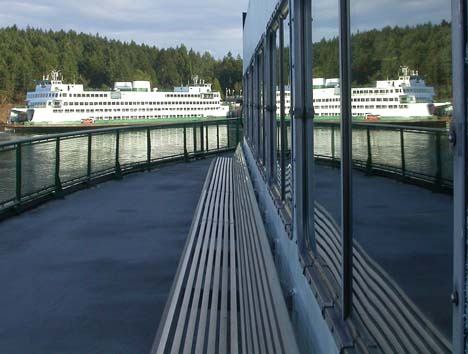Beginning in fall 2012, many of those coming to and from the San Juan Islands on a state ferry will need a reservation.
Washington State Ferries acknowledges that some customers are alarmed.
“WSF is committed to addressing these concerns and will work with a community and customer route-based partnership before any final decisions are made,” officials said.
Local residents rocked the boat at a May 6 inter-island meeting with ferry representatives. Among their questions: What if the community doesn’t want a reservation system? Will 2011 bring fare increases? How much? Do ferry schedules shape the demographics of our islands?
“It is a give and take,” WSF Assistant Secretary David Moseley said. “We do need to hear from our customers what will and will not work.”
Around 45 locals attended some portion of the session, and attendees were encouraged to voice their thoughts or fill out comment forms.
The state Legislature awarded WSF $5.8 million this March to implement a reservations system, a key goal in the organization’s 2030 long-range plan. Officials estimate reservations would reduce the need for expanded ferry terminals and holding areas, saving the state $280 million. They also expect to increase business in ferry-served communities and reduce traffic congestion and air pollution from idling vehicles.
WSF will spend some of the funds on increasing ferry ridership through marketing efforts, and hopes to partner with communities to promote activities on the west side of Puget Sound.
Moseley explained the following plan:
— Phase One (May 2010 to July 2011): studies and testing of the three routes already using a reservation system.
— Phase Two (July 2011 to 2015): implementation of a vehicle reservation system on all San Juan County routes.
— Phase Three (2015 to 2018): broadening of the vehicle reservation system to include central Puget Sound commuter routes.
WSF communications manager Joy Goldenberg told the Sounder that reservation specifics will be worked out community by community, based on voiced needs.
“We don’t have the details of the allotments on the boat, but … medical emergencies will always be a priority for the ferry system,” she said.
During Phase Two, WSF also hopes for approval to develop a real-time information system for ferry riders, similar to the live traffic signs that inform commuters in the Seattle area. Many ears perked up when Moseley said this system might include a sign located in Anacortes that announces whether scheduled ferries were running on time, late, or already filled to capacity, helping riders to decide whether to head out to the terminal, do some more shopping … or get a hotel room.
“A real-time information system goes hand in hand with a successful reservation system,” Goldenberg said.
WSF Planning Director Ray Deardorf summarized October’s annual fare change process: The Legislature specifies a revenue target, and based on this number, WSF gives a recommendation to the State Transportation Commission, which has the authority to set fares. The San Juan County Ferry Advisory Committee is now hearing public opinion on fares.
Regarding ferry schedules, residents expressed frustration with the continuous fiddling in recent years and requested a stable, season-based annual schedule.
“That would be a desire on our part too,” said Moseley, adding that schedule changes result from efforts to improve on-time performance.
One mother commuting from Shaw to San Juan said, “I’ve commuted on this boat for 10 years and this is the worst schedule I’ve ever commuted on … There is no continuity of transportation in our islands.” She said the ferry schedule does not make it easy to connect with buses or other forms of transportation in Anacortes.
Another commuter, a mother who lives on Orcas Island and commutes daily to work in Friday Harbor, said the decision to move the morning sailing half an hour earlier (in the newly presented summer schedule) could make her childcare drop-off and commute impossible.
“I’ll have to quit my job,” she said. “There are working professionals trying to live on Orcas. We need to get to town for work. THIS is our bus.”
“Unfortunately, it’s just not possible to do it all,” said Ferry Advisory Committee member Ed Sutton, who said meeting one request often involves denying another.
“You say you can’t meet everyone’s needs. Why not make young families who are trying to make a living a priority?” she responded, saying the presented schedule would help form a community of retired people rather than working parents.
County Councilman Bob Myhr, Lopez/Shaw, also spoke on behalf of commuters, saying most of the daily commuters from Orcas (about 40) and Lopez (about 30) could not attend because they were working.
“This inter-island connection cannot be emphasized enough,” he said. “We really appreciate the free inter-island walk-on; it’s really important that the ferry system continue to provide that service.”
Contact the Ferry Advisory committee representative for your island. On Lopez Island, John Whetten; Orcas Island, Ed Sutton or Lance Evans; San Juan Island, Howie Rosenfeld or Pat McKay; Shaw Island, John Brantigan. The committee does not yet have a Web site.
Comments may also be directed to Goldenberg at 206-515-3411, or by e-mail: wsfplanning@wsdot.wa.gov.
For more information, visit: www.wsdot.wa.gov/ferries/planning/vehiclereservations.htm



